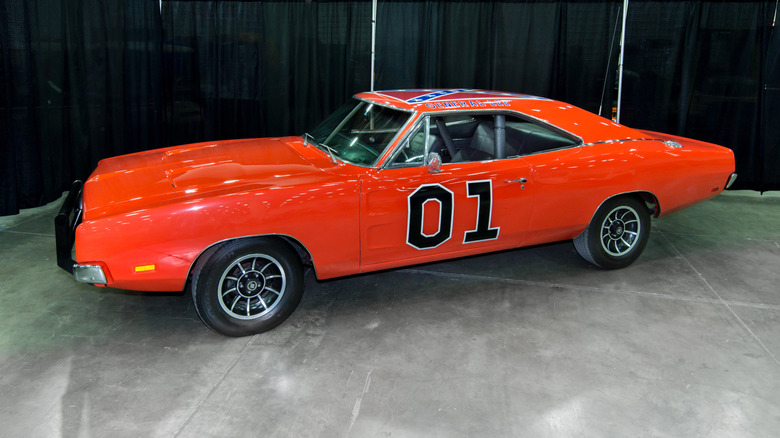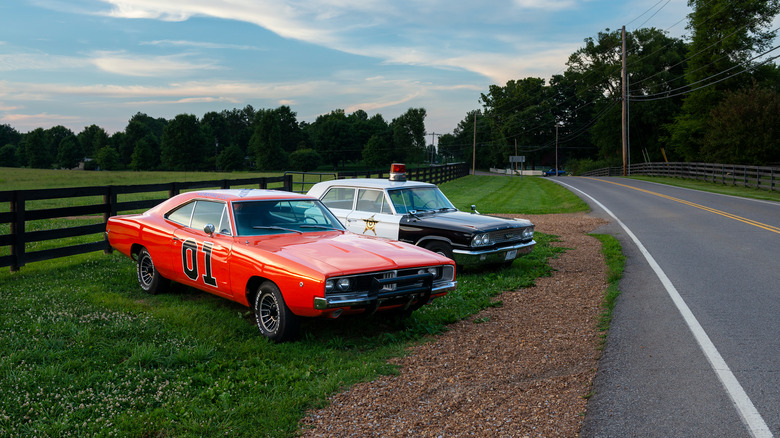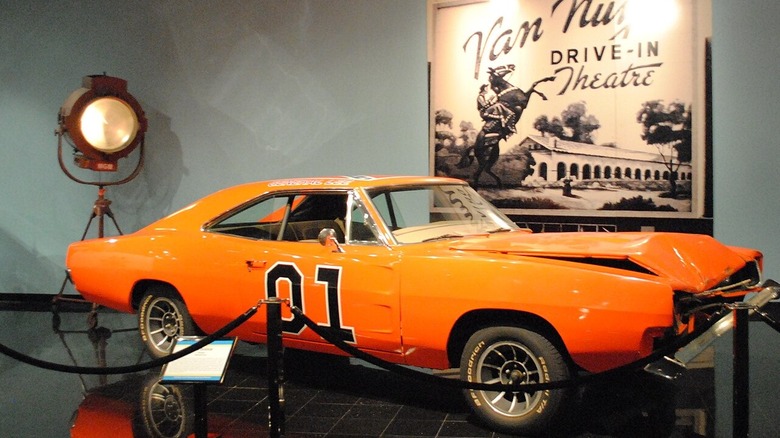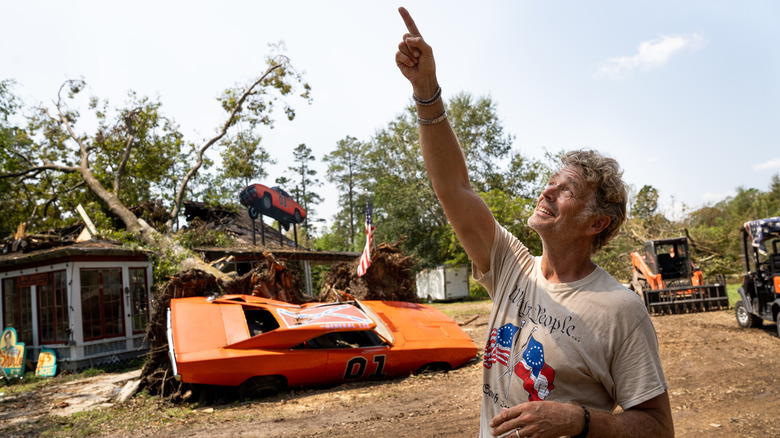5 Facts 'The Dukes Of Hazzard' Fans Should Know About The General Lee
"The Dukes of Hazzard" debuted on CBS on January 26, 1979, and introduced viewers to the Duke family — cousins Bo (John Schneider) and Luke (Tom Wopat), Daisy (Catherine Bach), and Uncle Jesse (Denver Pyle). As the show's theme song croons, Bo and Luke are just a couple of good ole boys from Hazzard County, Georgia, who never meant any harm but fought the system like a true modern-day Robin Hood. In this case, the "system" happened to be two bigger-than-life characters, the corrupt county commissioner, Boss Hogg (Sorrell Booke), and his sheriff, Rosco P. Coltrane (James Best), who was more likely to get in his own way than actually stopping the good-natured Duke boys.
Today, the show is best remembered for its 1969 Dodge Charger known as the General Lee, perhaps the most recognized car in TV/film history. We say perhaps because another iconic vehicle outshined it in our own poll. It appeared in all but one of the show's 146 episodes between January 1979 and February 8, 1985. While the show made Catherine Bach a Hollywood bombshell and turned her "Daisy Dukes" into slang for very short shorts, it was always best known for giving audiences a weekly serving of the General tearing through Hazzard County, making impossibly cool jumps over rivers, gorges, and police cars.
Its creation was an evolutionary process
The show was based on the 1975 film "Moonrunners" directed by Gy Waldron, highlighting the exploits of a moonshine-running family in the South with two cousins and Uncle Jesse. It even had a Sheriff named Roscoe Coltrane and Waylon Jennings telling the tale and singing songs as The Balladeer.
Unlike the TV show, "Moonrunners" did not feature a slick muscle car. After the film, Waldron developed the concept further with executives at Warner Bros. Television, who thought a fast vehicle was essential to the show. With all the shenanigans taking place in the South — specifically the fictional Hazzard County, GA — where NASCAR was incredibly popular, they figured they could use an old but theoretically still souped-up stock car. Waldron created the original General Lee design, not George Barris, who is often mistakenly credited because Barris was Hollywood's go-to man for designing vehicles.
Waldron initially wanted to use a Pontiac GTO, but since a glut of 1969 Dodge Chargers existed, they chose it over the GTO. It was sprayed with bright Hemi Orange paint, fitted with NASCAR-style doors, and plastered with the now-controversial Confederate flag, originally meant to go on the hood, not the roof. The "01" on the sides was a nod not only to its stock car roots but to Burt Reynolds' rebellious character Bo "Bandit" Darville from "Smokey and the Bandit."
It was packed with muscle but needed help to fly
The General is one of the fastest cars to be featured on TV, but it wasn't built to endure the abuse it received on the set. If drivers weren't losing control and crashing, the constant jumps did them in. The most ever performed in a single day was nine — none survived. Most cars were reinforced with a rollbar hoop, but the ones used for big jumps had a full roll cage. Every car had heavy-duty shock absorbers, springs added to the suspension, and a protective push bar on the front. The brakes were adjusted to make it easier for the driver to perform the often-used 180-degree "Bootleggers' Turn." According to Tom Sarmento, lead mechanic on set, they mostly used Chargers from 1969 and some from 1968, but none from the 1970 model year.
In scenes that needed dynamic driving techniques, the cars were powered by big block (383ci – 440ci) engines because they had more torque. Cars with smaller engines were equipped with nitrous oxide and used for midsized jumps to give them additional punch. In the famous record-breaking jump seen during the opening credits, The General went 16 feet high, traveled 82 feet — and was totaled when it landed, which initially was common because Chargers were nose-heavy thanks to the engine weight. To make them more aerodynamic, they put 300 – 500 pounds of lead in the trunks to balance out the weight and keep the nose up so it could land properly.
It was more popular than the human cast members
CBS chairman William Paley thought the whole concept of "The Dukes of Hazzard" was "lousy" and wasn't fond of the redneck humor showcased in the show. Meanwhile, the producers thought the show wouldn't last long enough to make it "past the first commercial." So, when it became a hit, they were shocked to find that all those Chargers they thought were available suddenly weren't.
Of the 60,000 fan letters received every month, more than half were addressed to the General Lee itself, asking for pictures, specs, and whatever other info they could get. Fans gobbled up millions of pieces of merchandise, including model kits, remote control cars, and lunch boxes. People even modified real-life autos to look just like the one on the show.
An incredible number of Chargers were used during the show's six seasons. Production went through 317 Chargers, with reports claiming as many as three were destroyed every episode. This, combined with the public's demand for the '69 Charger, created such a shortage the producers had to use modified AMC Ambassadors instead, tweaking camera angles and editing scenes to hide the car's differences. Producers went so far as to canvass Los Angeles County, putting notes on windshields and offering owners $500 for their Charger and a clean title. When that failed, a special effects company was hired to film jumps using miniatures.
Its 12-note horn has its own crazy backstory
You know the General's very distinctive horn when you hear it, even if you never set foot anywhere in the South. It plays the first 12 notes of a song called "Dixie" (aka "Dixie's Land"). Two origin stories exist about where the horn came from, both from very reputable sources.
Paul Picard, an executive at Warner Bros., claims that as he and the production crew were en route to film the show's very first episode, they heard the horn blaring from a passing vehicle. They immediately chased it down and offered to buy it on the spot. The driver was initially hesitant, but after they offered "five times the actual price of the horn," he relented. Picard said they later discovered it was widely available at auto parts stores and in J.C. Whitney catalogs at a fraction of the cost, but wanted it so badly at the time they didn't care.
The second story comes from lead mechanic Tom Sarmento, who claims that director Paul Baxley noticed it coming from a local food truck when it arrived to feed the crew. Sarmento claims it was only installed on the First Unit car driven by Schneider and Wopat.
"Dixie" was written by Daniel Decatur Emmett (a supporter of the Union) in 1859 and was initially performed in minstrel shows. The band played the song when Jefferson Davis took office as the Confederate President in 1861, and it quickly became the national anthem of the Confederacy.
Very few original Generals still exist
There are probably thousands of replica versions of the General running around (one of which belonged to John Schneider and was destroyed by Hurricane Ida), but you can count the number of show-used Chargers on just your fingers and toes. According to most sources, only 17 are still in existence today. However, in 2005, The Gainesville Sun reported that after the show got canceled, 19 were actually parked on a lot in California and forgotten. In 1991, Warner Brothers auctioned off 17 to private collectors, with the caveat they had to sign an NDA barring them from ever disclosing the purchase price.
We know the oldest surviving General Lee is located at the Volo Museum in Volo, Illinois. They also have a second Charger, but it was built to pop a wheelie and never actually used. Another of the original Generals sits in the Pioneer Auto Show in Murdo, South Dakota, which was procured from Cinema Vehicles in Hollywood, California, and another is on display at the Hollywood Stars Cars Museum in Gatlinburg, Tennessee. In 2023, the U.S. online edition of The Sun reported that another was involved in a single-car crash on Historic Highway 165 in Missouri. The rest are undoubtedly still in the hands of private collectors.



